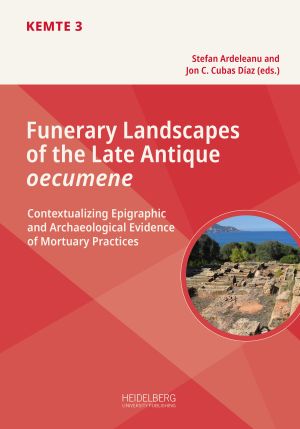Zitationsvorschlag
Lizenz (Kapitel)

Dieses Werk steht unter der Lizenz Creative Commons Namensnennung - Weitergabe unter gleichen Bedingungen 4.0 International.
Identifier (Buch)
Veröffentlicht
Materializing Death in Late Antique North Africa
Epitaphs, Burial Types and Rituals in Changing Funerary Landscapes
Abstract This contribution gives an updated overview of funerary habits and epigraphy in Late Antique North Africa. It covers a vast geographical area incorporating the provinces of Africa Proconsularis, Byzacena, Numidia Militana, Numidia Cirtensis, Mauretania Caesariensis and Mauretania Sitifensis. After Italy, North Africa has by far the highest number of preserved Late Antique epitaphs in the West, and in some regions (including rural areas) the abundance of epigraphic material can be taken as evidence for a veritable revival of written self-representation in funerary contexts. After a general decrease of epitaphs – still poorly understood – during the later 3rd and the 4th c. AD, many regions saw remarkable peaks in numbers in the 5th and 6th c. AD. This may be connected to general trends of economic and demographic stability, as well as to the spread of the popular martyr cults. At the same time, ‘interiorized inscriptions’ and ‘closed’ funerary spaces, but also ‘hidden’ epigraphic representation gained relevance, while the habit to express professions and offices was nearly totally abandoned (except for the military and the clerical milieu). Individual and familial funerary representation, however, was still practiced alongside the generally growing trend of collective representation in ‘homogenous’ epitaphs and funerary iconography.
The emphasis of this chapter is on the materiality of epitaphs, their integration in commemorative funerary rituals and the mutual interconnectedness between new developments in funerary customs, tomb types and epigraphic tomb signaling. The role of tombs as markers of social distinction in a period of transforming urban landscapes is analyzed by discussing several local case studies. Although many micro-regional differences in funerary practices can be traced, North Africa also shared multiple similarities with the Western and Central Mediterranean. Attentive analysis of the epitaphs’ materiality, their original spatial setting, their iconography and their visibility allows for reconstructions of social hierarchies, of liturgical movement and of their perception within these transforming funerary landscapes.
Keywords North Africa, funerary epigraphy, commemorative rituals, Late Antique tomb types, social hierarchies






